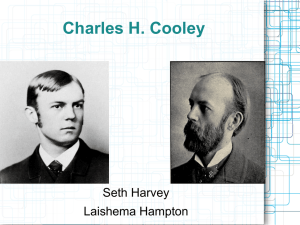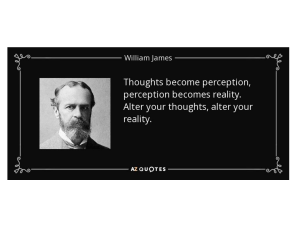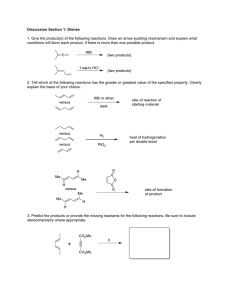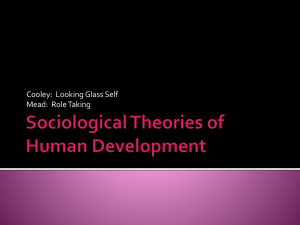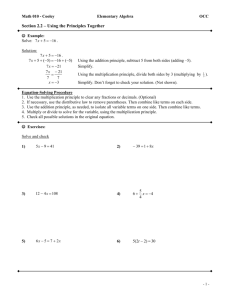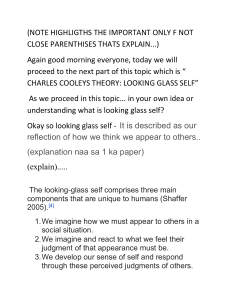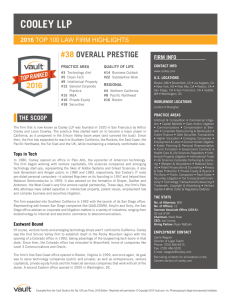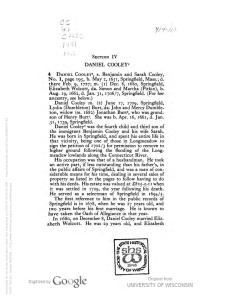Charles Cooley Presented by Zach and Griselda
advertisement
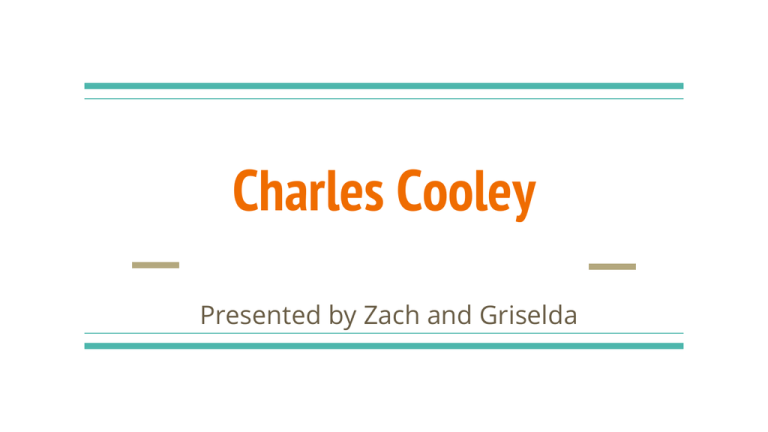
Charles Cooley Presented by Zach and Griselda Background Charles Horton Cooley (1864-1929) Father, Thomas Cooley, was an ambitious, outgoing man. Lawyer, justice of the Supreme Court of Michigan, Dean of the University of Michigan Law School Prone to illness as a child and had a speech impediment. Bachelors in Mechanical Engineering Not a subject he liked Background Married Elsie Jones and had 3 children Developed a strong interest in Sociology, but there was no such department at Michigan Ph.D. in political economy and minor in sociology Dissertation was The Theory of Transportation His work Pragmatism: “Held that truth was to be tested, above all, by the practical consequences of an idea, by action rather than theories” (Bailey, st al., 1998:583). Spent career devoted to self-examination and observation of the behavior of his children. Taught theory of evolution course at Michigan. Helped in founding of the American Sociological Association. Intellectual Influences William James Applied to society the kind of approach James applied to the self “Self” is similar to “social self” James Baldwin Uses much of the data from Baldwin’s case studies and social-psychological orientation. Pragmatism method Charles Darwin Admired sense of the complex interrelationships that governed the natural world. Concepts and Contributions - Organic View The Organic View of Society “All nature, all life, human life, and social life are interrelated, interdependent, and interconnected unities” Holistic view arguing no part of society should be considered in isolation Society lives and grows through interaction between parts Any harm to one part is a harm to the whole Triadic relationship: primary group, human nature, and looking-glass self Concepts and Contributions - Primary Group The Primary Group Groups “characterized by intimate face-to-face association and cooperation,” personal relationships, and Play a key role in linking individuals to society Earliest, most basic social unity experiences Fundamental Properties: 1. Face-to-face association 2. Unspecified nature of associations 3. Relative permanence 4. A small number of persons involved 5. Relative intimacy of participants Individuals forming a common whole Secondary Aim to Groups help group- members are related formally and impersonally To grow, new primary groups must be sought out Concepts and Contributions - Looking-Glass Self The Looking-Glass Self - An individual's self-image mirrors the imagined reactions of others to their appearance, demeanor, and behavior We see ourselves as others see us Received messages are interpreted Generally, reactions from significant others are more important than those from strangers Children learn that their actions cause reactions in others, allowing them to manipulate their environment Three key principles of the looking-glass self theory: 1. The imagination of our appearance to the other person 2. The imagination of their judgement of that appearance 3. Our resulting self-feeling such as pride or mortification Concepts and Contributions - The Self and “I” The Self - formed in society, flexible and changing, responds to experience Society and self are dialectical processes Self is formed in interaction with others while society is composed of many selves “I” - Pronoun used in a wide-variety of social contexts To Describe Feelings - ”Feeling aspect of self” not most important but most instinctual In Relation to the Body - “I” really refers to the opinions, feelings, and desires being express, not the material body In Relation to Habit - “habit and familiarity” are not enough for an idea to connect to the self In Inanimate Objects - we perpetuate “I” into inanimate objects To Society and Others - “I” relates to our self-feeling which is a product of our interactions Concepts and Contributions - Social Process Sympathetic Introspection - Putting one’s self in the place of the actor being studied in order to analyze consciousness Not just observing external behavior, but trying to understand why Social Process - Primary group’s moral unity becomes an individual's source of ideals which are then communicated, cementing social bonds. Social organization - unity of social mind (ideals) and social structure Public opinion - organic process where communication is key Consensus is an organization, a cooperative product or structure Questions Related to Charles Cooley Define these terms as they are used by Cooley: looking-glass self, primary and secondary groups. Describe how Cooley defines social process. Describe the key perspective by which Charles Cooley views society. Organic View of Society What do sociologists gain by viewing society from the perspective of Cooley? Sympathetic Introspection Pragmatism Describe one key limitation to the way that Charles Cooley views society. Sympathetic Introspection lacks scientific credibility of statistics and scientific method “Armchair sociologist” Idealism and optimism
